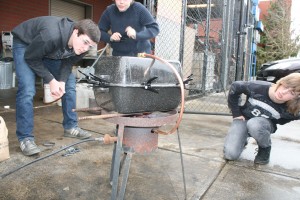Hands-on Learning with Biochar

Originally appears in the Fall 2012 issue
Shrinking your carbon footprint is a vital goal for the future of our society, and there are many ways to engage our students, friends and families in new ways to do this. But in addition to lowering carbon emissions, a greener future will also involve new technologies that have the potential to reduce carbon dioxide in our atmosphere. The emerging field of biochar production offers us the opportunity to capture CO2 and store it for thousands of years, while enriching our soil and helping plants grow.
Very simply, biochar is charcoal that is clean and safe to use for soil enhancement. Biochar is produced by baking biomass without the oxygen that would cause it to ignite and burn. Baking wood and other plant materials releases a flammable gas that yields energy. The implications of biochar in modern science are still being investigated, but the idea of adding charcoal to soil is based on very ancient traditions. Most notably, the Terra Preta (“black earth” in Portuguese) soils found in the Amazon River basin were created by indigenous people over a span of thousands of years, allowing them to grow crops that fed a population of millions.[i]
Scientists are interested in biochar for two main reasons: its value as a soil amendment, and its ability to sequester carbon in soil for the long term. It works as an agricultural additive by providing a stable carbon structure to soil that absorbs and holds nutrients and water, making them more available to plant roots. Charcoal does not degrade easily and can remain in soil for thousands of years. This quality gives it the potential to not only be an effective and long-term soil enhancer, but also offers a way to manage and even reduce CO2 production.
To view the photo-rich magazine version, click here.
If you are not already a subscriber, please subscribe to read the full article
Darlyn Wendlandt is the digital arts teacher at Heritage High School, who created an after-school project, to engage science students to make and test biochar. Kelpie Wilson is the Communications Editor for the International Biochar Initiative, in Cave Junction, Oregon.
Leave a Reply
You must be logged in to post a comment.





